This article was published in Scientific American’s former blog network and reflects the views of the author, not necessarily those of Scientific American
I'm a big fan of pigeons. They do lots of interesting things, they look neat, they're pretty 'extreme' when it comes to various of their abilties, and they're accessible and easy to watch. Comparatively few of us get to watch long sequences of behaviour in wild birds, but pigeons - here I'm talking about the feral/domestic form of the Rock dove or Rock pigeon Columba livia - provide those of us interested in birds with excellent views of... well, whatever it is they get up to. I'm particularly proud of this sequence of images, taken on the coast of Lyme Regis, Dorset (UK), earlier this year. A male pigeon and a female pigeon are observed engaging in courtship feeding...
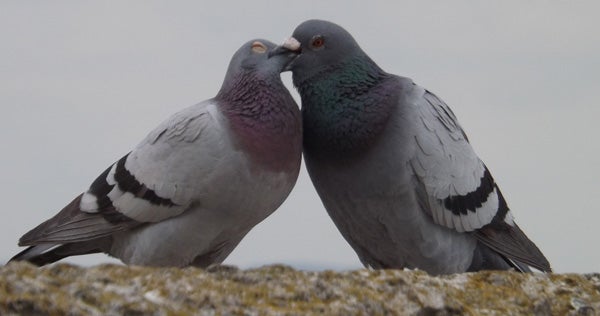
While (at this stage) it isn't completely obvious, I think that the bird on the right is the male. It looks slightly larger, and it seems to be doing most of the 'feeding'. The birds indulge in lots more of this behaviour...
On supporting science journalism
If you're enjoying this article, consider supporting our award-winning journalism by subscribing. By purchasing a subscription you are helping to ensure the future of impactful stories about the discoveries and ideas shaping our world today.
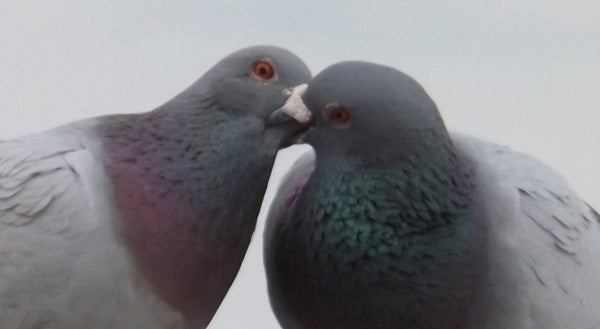
Now it's obvious that we can tell them apart by neck colour. The larger bird (the presumed male) has a green neck; the other bird (presumed female) has a reddish neck. While the behaviour that we're seeing here is called 'courtship-feeding', it apparently does not actually involve the passing of food (Goodwin 1967). Rather, it's a sort of stylised 'mock feeding' that pairs do to cement a bond. Presumably it evolved from ancestral pigeons that did pass food bill-to-bill as part of courtship.
The birds stop doing this, but it's obvious from their actions that they're going to return to it in a moment. Note that the green-necked bird has a larger, more bulbous cere than the red-necked one. This provides another indication that the green-necked bird is a male - males tend to have larger ceres than females. The cere, if you don't know, is a pale, soft mass of tissue at the base of the bill. It's not unique to pigeons: parrots, falcons, skuas, owls, some galliforms and others have ceres too. The structure has evidently evolved several times, independently. As to why the cere evolved... I don't know. In fact, I don't think anyone knows what its 'function' is.
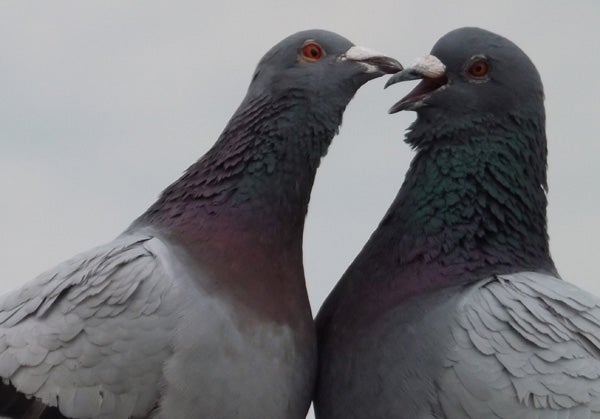
The birds return to their so-called courtship-feeding...
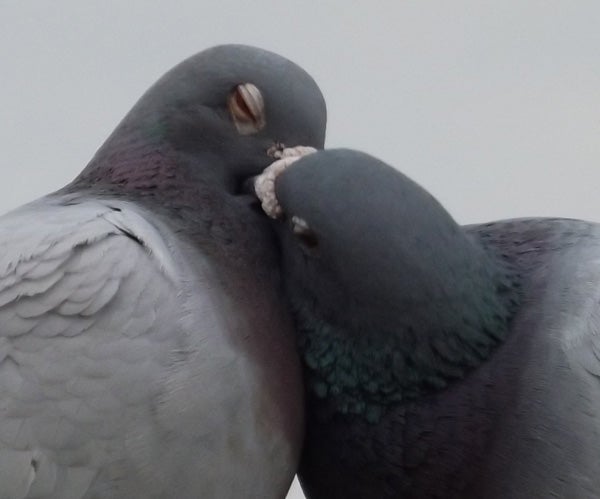
They then stop again, this time so that the green-necked bird (the presumed male) can indulge in a bird of preening. But is the bird preening because it really needs to, or is this a displacement activity of some sort? So-called displacement preening is a common behaviour of pigeons, especially by males during the buildup to copulation. "The function of this displacement-preening is to indicate the bird's sexual and peacable intentions and to arouse a similar mood in the partner" (Goodwin 1967, p. 34). Of course, there are those occasions where preening is just preening.
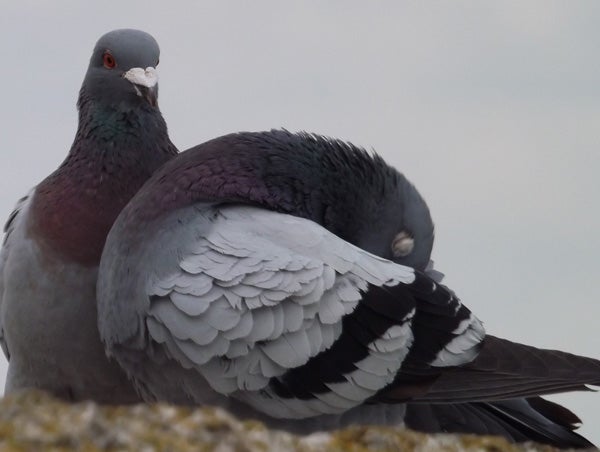
The pair return to their mock courtship-feeding again...
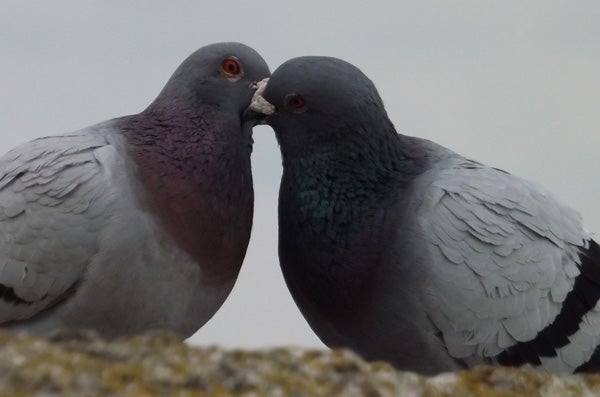
The birds then stop again. Those raised feathers (below) indicate readiness or excitement - something involving movement and a change of posture. Incidentally, note how the green-necked bird (now on the left) has a small dark element in the lower front corner of its eye. Similar features - termed eye flecks - are present in some pigeon species (Ryan 2013) and also in oystercatchers and a few other birds (Guzzetti et al. 2008). In these cases, the flecks are typical of females and mean that individuals can be sexed by eye form alone. However, eye flecks are not typical of C. livia. The individual shown here presumably just has unusually pigmented eyes.
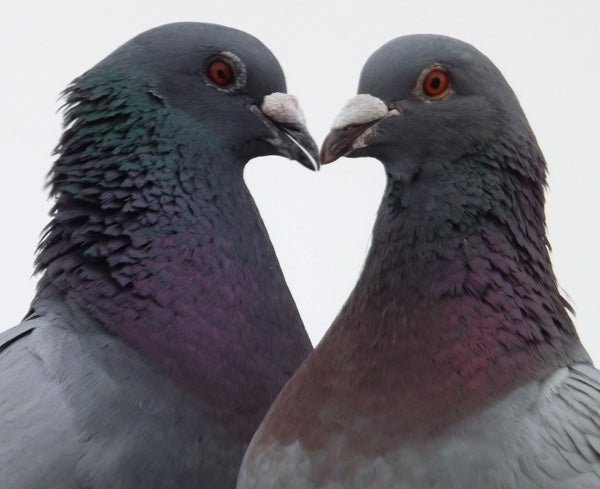
That cessation of courtship feeding, those raised feathers, it's all a prelude to the final act...
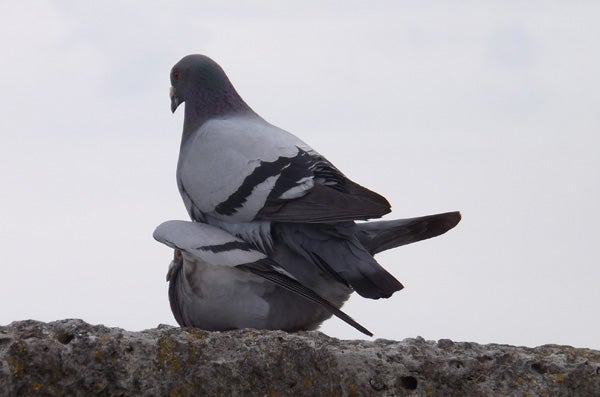
Mating is brief, taking about four seconds. The female moves her tail to the side and opens her wings, taking the full weight of the male.
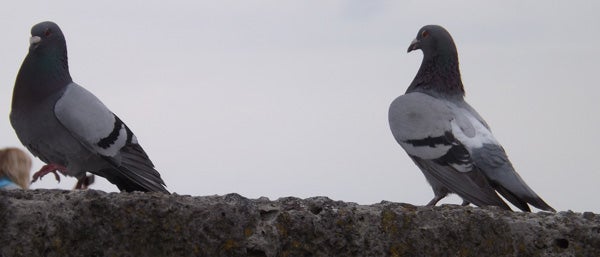
The pair part. It looks from this image as if the slightly dishevelled female is left to tidy herself up while the male struts away in macho fashion. While I'm trying not to anthropomorphosize, that's exactly what's happening. The male really is strutting in a high-stepping, head-down pose that means "I just had sex". Of course, this isn't the end of things - the pair will co-operate in building a nest and raising their clutch (Johnston & Janiha 1995). I'll finish by saying 'cropmilk'.
I hope you enjoyed this brief foray into the world of pigeon behaviour. For previous Tet Zoo articles on pigeons, see...
Refs - -
Goodwin, D. 1967. Pigeons and Doves of the World. British Museum (Natural History), London.
Guzzetti, B. M., Talbot, S. L., Tessler, D. F., Gill, V. A. & Murphy E. C 2008. Secrets in the eyes of Black Oystercatchers: a new sexing technique. Journal of Field Ornithology 79, 215-223.
Johnston, R. F. & Janiha, M. 1995. Feral Pigeons. Oxford University Press, Oxford.
Ryan, P. 2013. The eyes have it. African BirdLife Sept/Oct 2013, 29-34.